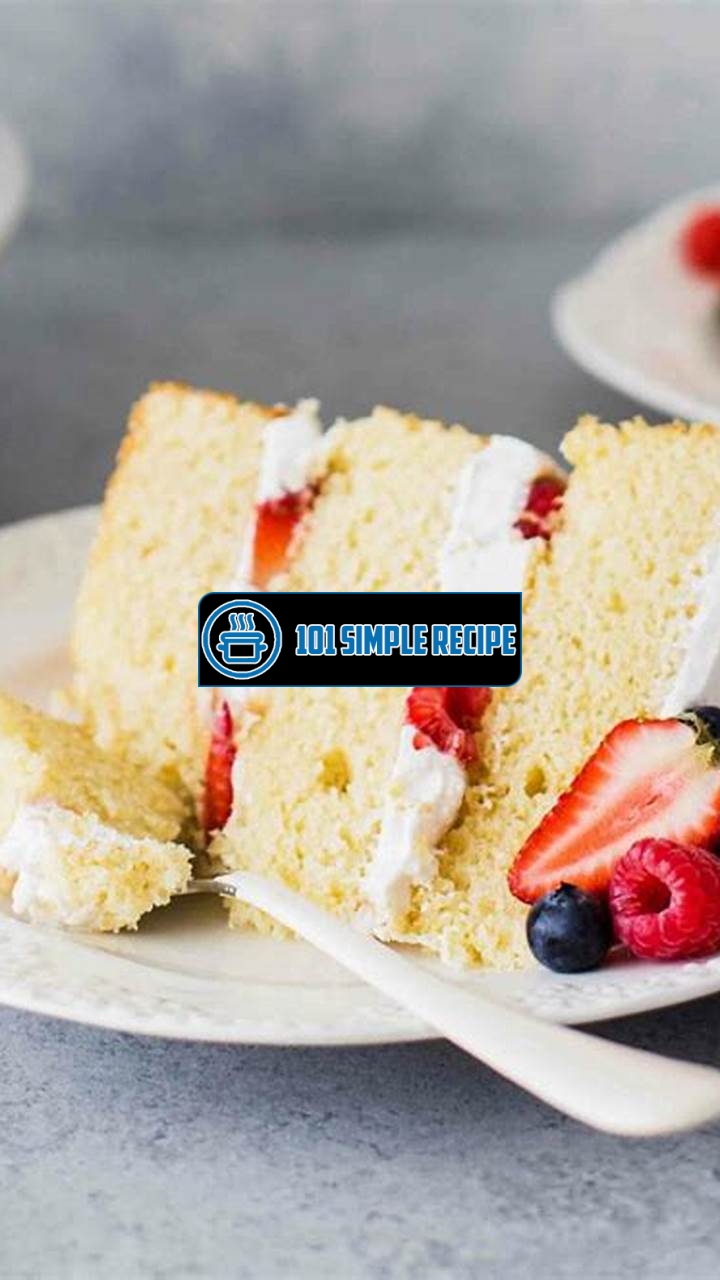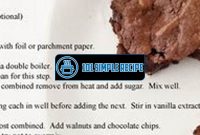Indulge in a heavenly treat with this decadent recipe for Vanilla Buttermilk Layer Cake. Whether you’re celebrating a special occasion or simply craving a delectable dessert, this cake will surely satisfy your sweet tooth. The combination of moist and tender vanilla cake layers, accompanied by a rich and creamy buttermilk frosting, creates a harmonious balance of flavors that’s simply irresistible. With its elegant appearance and heavenly taste, this Vanilla Buttermilk Layer Cake is guaranteed to be the highlight of any gathering. So, put on your apron and get ready to create a masterpiece that will impress your friends and family.

Understanding the Science Behind a Perfect Vanilla Buttermilk Layer Cake
Discover the secrets to baking a delectable vanilla buttermilk layer cake that will leave everyone craving for more.
The Role of Ingredients in Creating Flavorful Layers
When it comes to baking a perfect vanilla buttermilk layer cake, understanding the role of ingredients is crucial. Each ingredient contributes to the flavor, texture, and overall success of the cake. Let’s dive into the key components:
- Flour: The foundation of any cake, flour provides structure and stability. For the best results, use cake flour, which has a lower protein content and yields a tender crumb.
- Sugar: Besides adding sweetness, sugar also contributes to the texture and moisture of the cake. It helps create a tender and moist crumb.
- Eggs: Eggs bind the ingredients together, add moisture, and provide richness to the cake. They also contribute to the structure and rise of the layers.
- Butter: Butter adds flavor, moisture, and richness to the cake. Make sure it is at room temperature for easy incorporation into the batter.
- Buttermilk: Buttermilk plays a crucial role in creating a tender and moist cake. The acidity in buttermilk reacts with the leavening agents, resulting in a light and fluffy texture.
- Baking Powder and Baking Soda: These leavening agents help the cake rise by creating air bubbles in the batter. Baking powder reacts with moisture and heat, while baking soda reacts with acidic ingredients like buttermilk.
- Salt: Salt enhances the flavor of all the ingredients and balances the sweetness of the cake.
- Vanilla Extract: Vanilla extract adds a delightful aroma and flavor to the cake. Use pure vanilla extract for the best results.
Note: The quality of ingredients can greatly affect the taste and final outcome of the cake. Always choose high-quality ingredients for the best results.
Mastering the Art of Mixing and Measuring
Proper mixing and measuring techniques are essential for achieving a perfect vanilla buttermilk layer cake. Here are some tips to help you master the art:
- Measure Accurately: Use proper measuring cups and spoons to measure the ingredients accurately. A slight variation in measurements can affect the texture and taste of the cake.
- Creaming Method: Cream the butter and sugar together until light and fluffy. This step helps incorporate air into the batter, resulting in a tender and moist cake.
- Alternating Dry and Wet Ingredients: When adding the dry ingredients (flour, baking powder, baking soda, and salt) and buttermilk to the batter, alternate between the two. This technique ensures even distribution and prevents overmixing.
- Do Not Overmix: Overmixing can lead to a tough and dense cake. Mix the batter until the ingredients are just combined.
- Baking Time and Temperature: Follow the recipe instructions for baking time and temperature. Every oven is different, so keep an eye on the cake and perform the toothpick test to check for doneness.
Choosing the Right Baking Tools and Equipment
Having the right baking tools and equipment can make a significant difference in the outcome of your vanilla buttermilk layer cake. Here are some essentials:
- Cake Pans: Use round cake pans, preferably 8 or 9 inches in diameter, with straight sides. This allows for even baking and easy assembly of the layers.
- Parchment Paper or Non-Stick Spray: Line the bottom of the cake pans with parchment paper or use a non-stick spray to prevent sticking. This ensures easy removal of the cake layers.
- Cooling Racks: Cooling racks allow proper air circulation and help cool the cake layers evenly.
- Spatula: A rubber spatula is essential for folding in the dry ingredients and buttermilk without overmixing.
- Cake Leveler: A cake leveler is helpful for achieving even and flat cake layers, ensuring a professional-looking cake.
By understanding the science behind a perfect vanilla buttermilk layer cake and following the right techniques, you can create a decadent dessert that will impress everyone who takes a bite. Happy baking!
Step-by-Step Guide to Baking the Perfect Vanilla Buttermilk Layer Cake
Follow these detailed instructions to achieve a beautifully moist and delicious vanilla buttermilk layer cake.
Preparing the Cake Batter
To begin making the vanilla buttermilk layer cake, you’ll need the following ingredients: all-purpose flour, baking powder, salt, unsalted butter, granulated sugar, vanilla extract, eggs, and buttermilk. Assemble all of these ingredients and set them aside.
In a large bowl, whisk together 2 and ½ cups of all-purpose flour, 2 and ½ teaspoons of baking powder, and ½ teaspoon of salt. Ensure that these dry ingredients are well combined.
In a separate mixing bowl, cream together 1 cup of unsalted butter and 2 cups of granulated sugar. Use an electric mixer to make this process easier and faster. Keep mixing until the mixture becomes light and fluffy.
Add in 4 eggs, one at a time, beating well after each addition. This will ensure that the eggs are fully incorporated into the batter and contribute to the desired texture.
Stir in 1 teaspoon of vanilla extract and mix until it is well combined with the batter.
Now, alternate adding the dry ingredients and buttermilk into the batter. Begin with adding a third of the dry ingredients, then half of the buttermilk, followed by another third of the dry ingredients, the remaining buttermilk, and finally the last third of the dry ingredients. Mix each addition just until combined before adding the next.
Continue to mix until the batter is smooth and well blended. Be careful not to overmix, as this can result in a tougher texture.
Baking and Cooling the Cake Layers
Preheat your oven to 350°F (175°C). Grease and flour your cake pans to prevent the layers from sticking.
Divide the cake batter equally between the prepared pans, making sure to smooth the tops using a spatula or the back of a spoon.
Place the pans in the preheated oven and bake for approximately 25-30 minutes, or until a toothpick inserted into the center of the cakes comes out clean. Keep a close eye on the cakes towards the end of the baking time to avoid overcooking.
Once the cakes are done, remove them from the oven and let them cool in the pans for about 10 minutes. Then, transfer the cakes onto wire racks to cool completely.
Allow the cake layers to cool completely before moving on to the next step. This will prevent the frosting from melting and ensure a beautiful presentation.
Assembling and Frosting the Cake Layers
When the cake layers are completely cooled, it’s time to assemble and frost the cake.
Place one cake layer on a serving plate or cake stand. Spread a generous amount of frosting evenly over the top of this layer, using a spatula to create a smooth and even surface.
Gently place the second cake layer on top of the frosted one. Repeat the frosting process by spreading a generous amount of frosting on top of the second layer.
If desired, add a third cake layer and repeat the frosting process. This will create an even taller and more decadent cake.
Finally, frost the sides of the cake, working your way around until the entire cake is covered. Use the spatula to create a beautiful, smooth finish.
Decorate the cake as desired, using additional frosting, sprinkles, or fresh fruit.
Once the cake is assembled and frosted, refrigerate it for at least 1 hour to allow the frosting to set and the flavors to meld together.
When you’re ready to serve, slice the cake into generous portions and enjoy!
Remember:
- Follow the recipe closely for best results.
- Ensure the cake layers are completely cooled before frosting.
- Use good quality ingredients for the best flavor.
- Feel free to get creative with the decorations and customize the cake to your liking.
If you’re looking for more delicious cake recipes, check out our White Castle recipe. It’s a unique twist on a classic burger that you don’t want to miss!
Troubleshooting Tips for Common Vanilla Buttermilk Layer Cake Issues
Vanilla buttermilk layer cakes are a delightful treat that can satisfy any sweet tooth. However, even the most experienced bakers can encounter issues when preparing this decadent dessert. To ensure your cake turns out perfect every time, we’ve compiled some troubleshooting tips to overcome common problems that may arise during the baking process.
Dealing with Dry or Crumbly Cake Layers
One of the most disappointing issues you may encounter when baking a vanilla buttermilk layer cake is ending up with dry or crumbly cake layers. Fortunately, there are a few techniques you can employ to rectify this problem and achieve a moist and tender texture.
- Moisture is key: Ensure you measure all the ingredients accurately, paying special attention to the liquid components. Adding an extra tablespoon of buttermilk to the batter can help keep the cake layers moist.
- The power of oil: Consider substituting a portion of the butter with vegetable oil. Oil adds moisture to the cake and can help prevent dryness.
- Buttermilk to the rescue: If you find that your cake layers are still dry, you can sprinkle a layer of buttermilk on each layer before frosting them. The buttermilk will soak into the cake layers, making them more moist and flavorful.
By following these tips, you can turn dry and crumbly cake layers into a moist and delicious masterpiece that will impress your guests.
Fixing Sinking or Uneven Cake Layers
Another common issue encountered when baking a vanilla buttermilk layer cake is the occurrence of sinking or uneven cake layers. These problems can be frustrating, but with a few adjustments, you can ensure your cake layers rise evenly and have a consistent texture.
- Preheat and stabilize: Make sure your oven is preheated to the correct temperature before you start baking. Additionally, avoid opening the oven door frequently as this can cause the cake layers to sink due to temperature fluctuations.
- Level the playing field: Use a serrated knife or a cake leveler to trim the top of the cake layers to create an even surface. This will help prevent uneven stacking and ensure a stable structure.
- Optimal baking time: Avoid over-mixing the batter, as this can result in air pockets and uneven baking. Follow the recommended baking time and rotate the cake pans halfway through to promote even heat distribution.
With these simple adjustments, you can achieve perfectly risen and leveled cake layers, allowing for a visually pleasing final result.
Addressing Issues with Frosting and Decorations
While the cake layers are the foundation of a vanilla buttermilk layer cake, the frosting and decorations add the finishing touches. However, issues with frosting consistency or decorating techniques can sometimes arise. Here are some tips to help you overcome these challenges:
| 1. Consistent frosting: | Ensure your frosting has a smooth and spreadable consistency by gradually adding liquid (such as milk or cream) to thin it out or confectioners’ sugar to thicken it, as needed. |
| 2. Crumb coat: | To achieve a professional-looking finished cake, apply a thin layer of frosting, known as a crumb coat, before applying the final layer. This will help trap any loose crumbs and create a smooth surface for the final decoration. |
| 3. Creative decorations: | Let your creativity shine through by experimenting with different piping techniques, edible decorations, or fresh fruits. Don’t be afraid to try new things and make your vanilla buttermilk layer cake truly unique. |
By following these tips, you can tackle any frosting or decoration challenges and create a visually stunning cake that is as delightful to look at as it is to taste.
Remember, baking is a blend of science and art. Don’t be discouraged if you encounter setbacks along the way. With practice and these troubleshooting techniques, you’ll be able to overcome any issues and create a decadent vanilla buttermilk layer cake that will have everyone asking for seconds!
Adding Flair: Variations and Creative Ideas for Your Vanilla Buttermilk Layer Cake
Elevate your vanilla buttermilk layer cake with these imaginative twists and flavor combinations. Creating a delicious vanilla buttermilk layer cake is just the beginning. To really impress your guests and add some excitement to your dessert table, consider trying out these variations and creative ideas:
1. Exploring Different Frosting Options and Decorative Techniques
To truly make your vanilla buttermilk layer cake stand out, experiment with different frosting options and decorative techniques. Here are some ideas to get you started:
- Whipped Cream: Replace the traditional buttercream frosting with light and fluffy whipped cream for a lighter, more refreshing taste.
- Cream Cheese Frosting: Add a tangy twist to your cake by using cream cheese frosting instead of the usual buttercream. The creamy and slightly tangy flavor pairs perfectly with the sweetness of the cake.
- Chocolate Ganache: Take your cake to the next level by drizzling a rich and glossy chocolate ganache over the top. Not only does it add a decadent touch, but it also pairs beautifully with the vanilla and buttermilk flavors.
- Piping and Decorative Techniques: Use different piping tips and techniques to create beautiful designs and patterns on your cake. Whether it’s classic rosettes, intricate lace details, or playful polka dots, the options are endless.
Note: Remember to let your creativity shine through when it comes to frosting and decorating your vanilla buttermilk layer cake. Don’t be afraid to experiment and have fun!
2. Infusing Unique Flavors and Fillings into the Cake Layers
While vanilla buttermilk is a classic and delicious flavor combination, you can take it up a notch by infusing unique flavors and fillings into the cake layers. Here are some ideas to inspire you:
- Citrus Zest: Add a burst of freshness to your cake by incorporating lemon, orange, or lime zest into the batter. The citrus flavors will add a tangy and aromatic element to every bite.
- Fruit Preserves: Spread a layer of your favorite fruit preserves, such as raspberry or strawberry, between the cake layers for a burst of fruity goodness.
- Nutty Crunch: Mix chopped nuts, such as almonds or pecans, into the cake batter for added texture and a subtle nutty flavor.
- Spiced Layers: Add warmth and depth to your cake by incorporating spices like cinnamon, nutmeg, or cardamom into the batter. These spices will transform a simple vanilla cake into a fragrant and comforting treat.
Note: Don’t be afraid to mix and match flavors and fillings. Get creative and explore different combinations to find your perfect balance of tastes!
3. Customizing the Presentation for Special Occasions
When it comes to special occasions, the presentation of your vanilla buttermilk layer cake can make all the difference. Consider customizing the cake’s presentation to match the theme or mood of the event. Here are some ideas:
- Layered Ombre Cake: Create a stunning ombre effect by tinting the cake layers in different shades of the same color. This adds a visually striking element to your cake and is perfect for birthday parties or bridal showers.
- All-White Elegance: For a more elegant and sophisticated look, decorate your cake with white buttercream, edible pearls, and fresh flowers. This timeless presentation is ideal for weddings or formal gatherings.
- Seasonal Accents: Incorporate seasonal elements such as edible flowers, fresh fruits, or festive sprinkles to reflect the time of year. This adds a charming touch and celebrates the flavors of the season.
- Personalized Toppers: Add a personalized touch by creating custom cake toppers that reflect the occasion or the recipient’s interests. This not only makes the cake extra special but also serves as a wonderful keepsake.
Note: Remember that the presentation of your vanilla buttermilk layer cake is an opportunity to showcase your creativity and make a lasting impression. Tailor it to the occasion and have fun with it!
Looking to shed some pounds? Our weight loss recipe is packed with healthy ingredients to help you reach your goals.
Serving and Storing Your Vanilla Buttermilk Layer Cake
So you’ve successfully baked a decadent vanilla buttermilk layer cake and now it’s time to serve and store it. To make the most of your delicious creation and ensure its freshness, it’s important to follow some best practices. Here are some tips for presenting and garnishing the cake, proper storage techniques, and refreshing any leftover cake:
Tips for Presenting and Garnishing the Cake
When it comes to presenting your vanilla buttermilk layer cake, the possibilities are endless. Here are a few tips to make your cake look as enticing as it tastes:
- Prepare a beautiful cake stand or platter to showcase your creation. A simple and elegant stand can do wonders for the overall presentation.
- Consider adding a decorative cake topper or edible garnishes like fresh berries, edible flowers, or shaved chocolate.
- Create a frosting border around the edges of each layer to give your cake a polished and professional look.
Remember, presentation is key when it comes to making a memorable impression with your vanilla buttermilk layer cake!
Proper Storage Techniques for Optimal Taste and Texture
After indulging in a slice or two, you’ll want to store your vanilla buttermilk layer cake properly to maintain its taste and texture. Here’s how:
- Before storing, make sure your cake has completely cooled. Warm cakes can create condensation, leading to a soggy texture.
- Wrap the entire cake in plastic wrap or place it in an airtight container to prevent it from drying out or absorbing any odors from the refrigerator.
- If your cake has already been frosted, it’s best to refrigerate it. However, if your kitchen is cool and dry, you can store the cake at room temperature for a day or two.
- If you plan on storing the cake for more than a day, it’s a good idea to frost it no earlier than the day you intend to serve it. This will help retain its freshness.
By following these storage techniques, you can ensure that your vanilla buttermilk layer cake stays moist and delicious for as long as possible!
Refreshing Leftover Cake: Reviving Stale Layers
Have some leftover vanilla buttermilk layer cake that has lost its freshness? Don’t worry, there are ways to revive stale layers and enjoy them once again:
- If the cake has just started to stale and is still relatively fresh, you can try placing a slice of apple or a piece of bread on top of the cake in an airtight container. The moisture from the apple or bread can help soften the cake.
- If the cake has become dry and crumbly, consider turning it into a trifle by layering the cake with whipped cream, fresh fruit, and a drizzle of syrup or liqueur.
- You could also transform the stale cake into cake pops by crumbling it up, mixing it with frosting, shaping it into bite-sized balls, and coating them with melted chocolate or sprinkles.
With a little creativity, you can give your stale vanilla buttermilk layer cake a new lease on life!
If you’re hosting a party, our punch bowl recipe is a must-try. It’s a crowd-pleasing drink that will impress your guests.
Thank you for taking the time to read our article on the vanilla buttermilk layer cake recipe. We hope you found it helpful and inspiring for your next baking adventure. Remember, baking is a form of art where you can unleash your creativity and bring joy to those around you. Don’t hesitate to visit our website again for more delicious recipes and helpful tips. Happy baking!
Frequently Asked Questions
Here are some common questions about the vanilla buttermilk layer cake recipe:
| No. | Questions | Answers |
|---|---|---|
| 1 | How can I make the cake more moist? | To make the cake more moist, you can try adding an extra tablespoon of oil or melted butter to the batter. You can also brush simple syrup onto each layer before frosting. |
| 2 | Can I substitute buttermilk with regular milk? | Yes, you can substitute buttermilk with regular milk. Simply add a tablespoon of vinegar or lemon juice to a cup of milk and let it sit for 5 minutes to curdle before using it in the recipe. |
| 3 | How can I prevent the cake layers from sticking to the pans? | To prevent the cake layers from sticking to the pans, grease the pans with butter or cooking spray and line the bottoms with parchment paper. This will make it easier to remove the cakes once they are baked. |
| 4 | Can I use a different frosting instead of buttercream? | Absolutely! While this recipe recommends a classic buttercream frosting, you can experiment with different frostings such as cream cheese frosting, chocolate ganache, or even a whipped cream topping. |
| 5 | Can I freeze the cake? | Yes, you can freeze the cake layers. Wrap each layer tightly in plastic wrap and place them in an airtight container or freezer bag. They can be stored in the freezer for up to 2 months. Thaw the layers in the refrigerator before assembling and frosting the cake. |
| 6 | Can I make cupcakes instead of a layer cake? | Absolutely! This recipe can be easily adapted into cupcakes. Simply divide the batter evenly into cupcake liners and adjust the baking time to around 20 minutes or until a toothpick inserted comes out clean. |
Thank You for Reading!
We would like to express our gratitude for joining us on this baking journey and exploring the delicious world of vanilla buttermilk layer cake. We hope you enjoyed the article and feel inspired to create your own masterpiece. Remember, baking is both a science and an art, so don’t be afraid to experiment and make it your own. Visit us again for more mouthwatering recipes and baking tips. Happy baking!
Jump to Recipe
Vanilla Buttermilk Layer Cake

A delightful vanilla buttermilk layer cake that is moist, fluffy, and bursting with flavor. Perfect for any occasion or celebration.
- 2 cups all-purpose flour
- 1 1/2 teaspoons baking powder
- 1/2 teaspoon baking soda
- 1/4 teaspoon salt
- 1/2 cup unsalted butter (softened)
- 1 1/2 cups granulated sugar
- 2 large eggs
- 1 teaspoon vanilla extract
- 1 cup buttermilk
- Preheat the oven to 350°F (175°C). Grease and flour two 9-inch round cake pans.
- In a medium bowl, whisk together the flour, baking powder, baking soda, and salt. Set aside.
- In a large bowl, cream together the softened butter and granulated sugar until light and fluffy.
- Beat in the eggs, one at a time, followed by the vanilla extract.
- Gradually add the dry ingredients to the butter mixture, alternating with the buttermilk. Begin and end with the dry ingredients.
- Divide the batter evenly between the prepared cake pans. Smooth the tops with a spatula. Bake for 25-30 minutes, or until a toothpick inserted into the center comes out clean.
- Allow the cake layers to cool in the pans for 10 minutes, then transfer them to wire racks to cool completely. Once cooled, frost the cake layers with your favorite buttercream frosting.
- Slice and serve the vanilla buttermilk layer cake. Enjoy!






